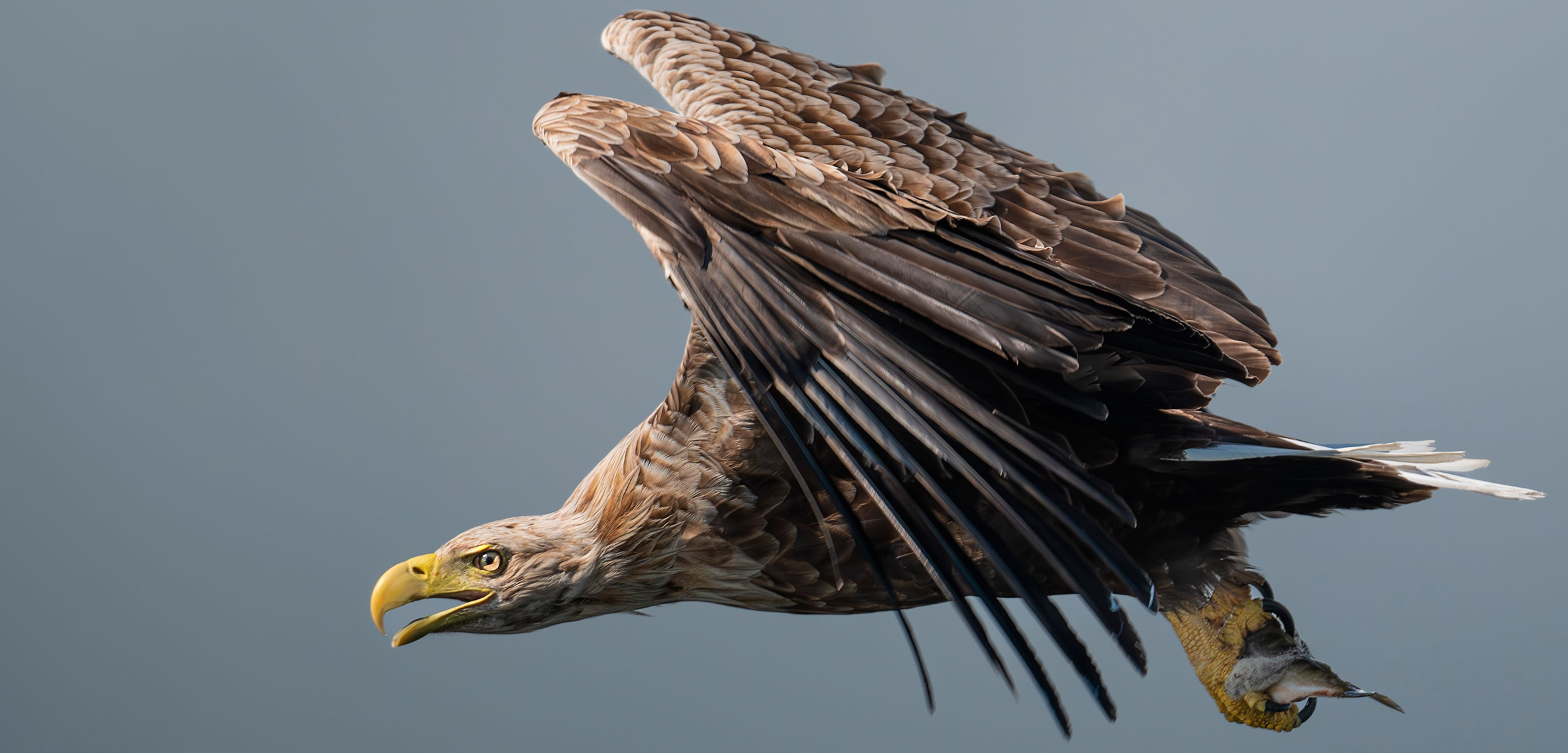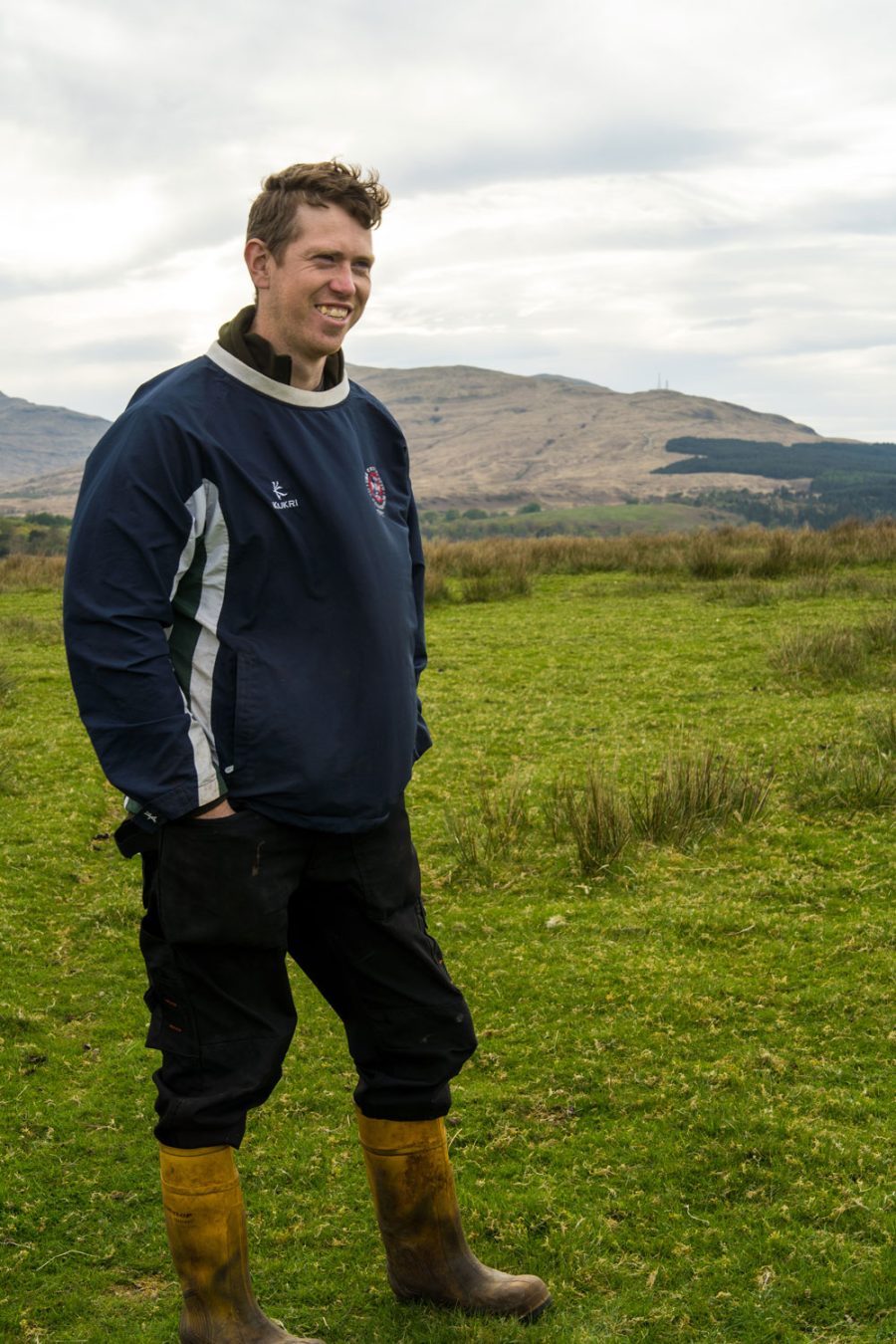The Sea Eagles That Returned to Mull
Almost 50 years ago, conservationists reintroduced white-tailed eagles to Scotland. It’s gone well. Some say too well.
Article body copy
She comes winging in from behind us, looming into our field of vision, seeming almost too massive to be airborne. She is a white-tailed eagle, one of a species of sea eagles. Haliaeetus albicilla is a close cousin of the North American bald eagle, with its same dour expression, outsized muppety beak, and slightly ramshackle habit of motion, landing like a winter coat falling off a hook. The wingspan of a big female can reach 2.5 meters. These are mythically big animals. Their size makes them bold. They lack the furtive elegance of so many other wild animals. They look casual, like they own the place.
The place owned by this particular eagle is the Isle of Mull, a rugged island off the west coast of Scotland. I am sitting in a truck, parked near a small copse of spruce. Next to me, with a scope mounted on his windowsill, is Dave Sexton from the Royal Society for the Protection of Birds, who has studied and protected eagles on and off on Mull since the 1980s. As we watch the eagle approach her nest, we see that she carries a twig in her yellow dinosaur talons. Sexton explains that this pair lost their chick a few weeks ago when a spell of cold and wet weather happened to hit the island just after hatching. With their nestling dead, the couple seem lost. Although white-tailed eagles almost never lay a second clutch, the pair add sticks to their already built nest, perhaps compelled to do so by the stimulus of it being empty.
This pair of eagles have raised several chicks in years past. A local sheep farmer named Jamie Maclean had complained that they were raising their chicks on a steady diet of his newborn lambs, which are born in spring, just as chicks hatch. And so, with Sexton’s help, the Scottish government agreed to pay for some “diversionary feeding.” Maclean would buy fish from a local fishmonger—at retail prices—with government money, and then put them out for the eagles to eat. The idea was that with the free fish rolling in, they’d leave the lambs alone.
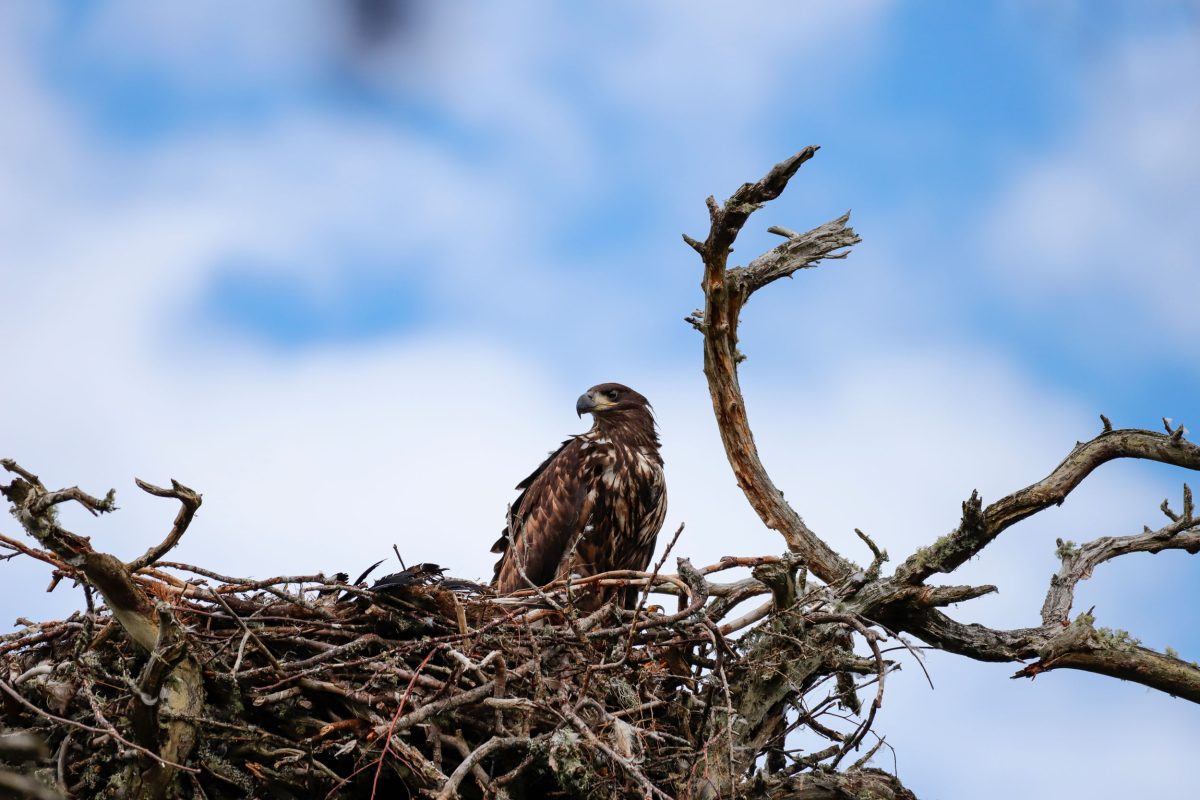
Around 22 pairs of white-tailed eagles are found on Scotland’s Isle of Mull. Photo by Ian Hague/Shutterstock
“So you can’t quite see it,” Sexton says, pointing out the window of the truck. “But just on the other side of that trailer, up on the hill, there’s a very prominent mound in the middle of a field.” It is here that the farmer offers up his fish.
“You realize this sounds like some sort of Iron Age ritual?” I ask.
“It does a bit,” he says, chuckling.
Sexton believes that eagles take far fewer lambs than other birds, such as hooded crows, ravens, and black-backed gulls. But he still thinks the diversionary feeding program is worth the expense—even if it is mostly a gesture of goodwill. “If I can do something like help with the diversionary feeding … the fact that the eagles are taking fish and not hanging around the lambs, that’s a good thing.”
I am planning to meet with Maclean. I am curious to know how he feels about this pair, after feeding them for years and watching them raise several generations of chicks. I wonder if their intimacy has made him feel any warmth toward them, despite their predatory interest in his lambs.

Sea eagles, including the white-tailed eagle pictured above, prey on salmon and mackerel, as well as ducks and seabirds. They sometimes eat lambs. Photo by Colin Black/Alamy Stock Photo
White-tailed eagles once lived across most of Eurasia. As far as scholars can tell by the hoards of their talons in at least one burial site, in antiquity they were symbolically potent, but as Europe became increasingly agrarian, they gained a reputation as a threat to livestock, and they were shot and poisoned out of most countries in western Europe in the 19th and early 20th centuries. The last well-attested eagle seen in Scotland was shot in Shetland in 1918.
Then, starting in 1975, conservationists reintroduced sea eagles from Norway to the Scottish Isle of Rhum, a nature reserve about 30 kilometers north of Mull. By 1985, a single pair had arrived in Mull and constructed a large sprawling nest in which a chick successfully hatched. Today, there are some 22 mating pairs on Mull, which is about 875 square kilometers, roughly the size of New York City.
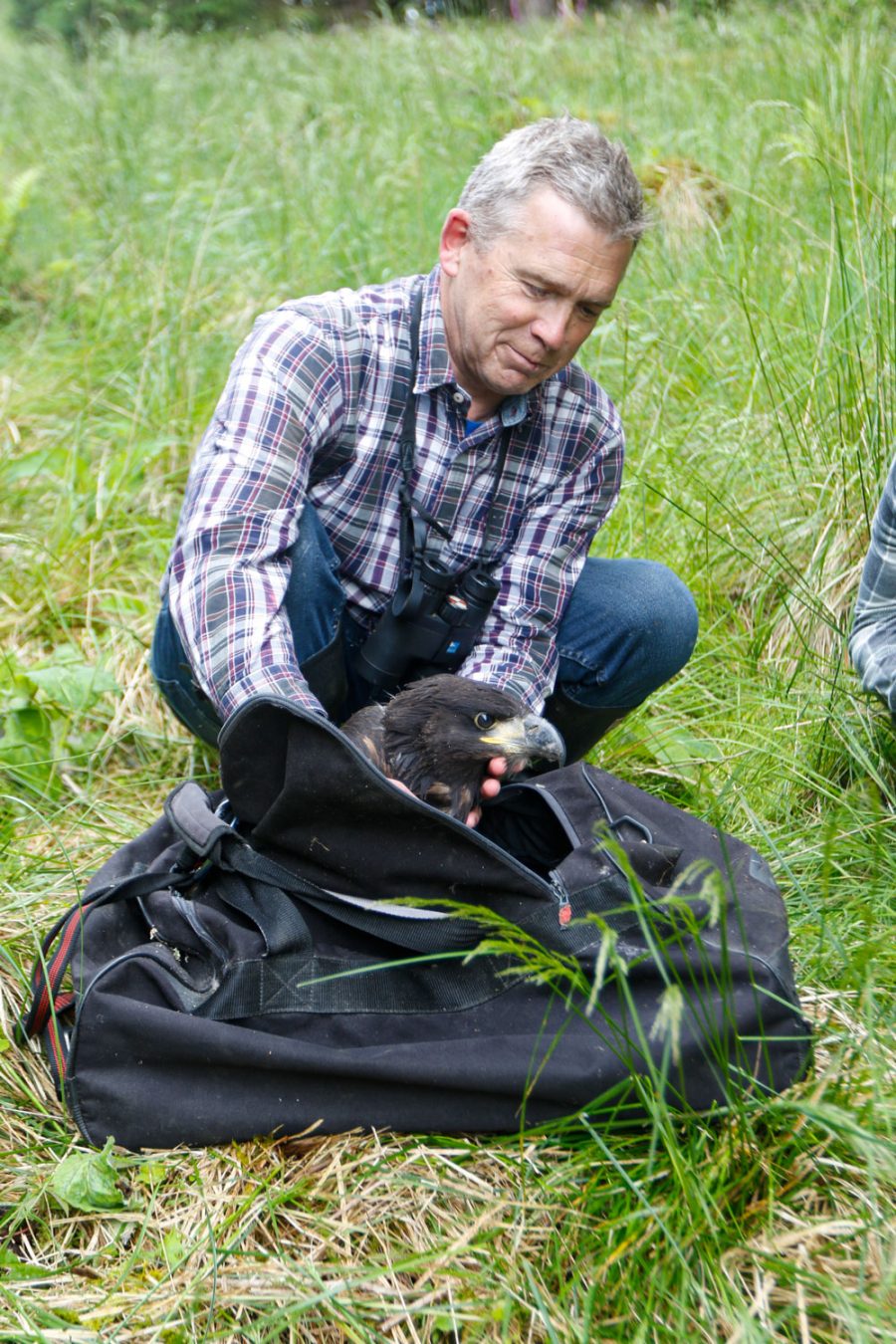
Dave Sexton, from the Royal Society for the Protection of Birds, has studied and protected eagles on and off on Mull since the 1980s. Photo by Nic Davies
When the eagles first returned, sheep farmers were not happy. Their grandfathers had killed these birds for a reason. But now nearly 40 years have passed—more than a generation—since the birds returned. I went to Mull because I wanted to see whether time had softened the acrimony that can accompany a reintroduction of a controversial animal. Would younger farmers who had never known a Mull without eagles still see them as an unwelcome presence, imposed upon them by clueless citified nature worshipers? Or would they have gotten used to them, enjoyed the fruits of the tourism they attract—up to £8-million (US $10-million) according to one estimate—and maybe even learned to love them a little bit?
The next day, I drive to meet Jamie Maclean at one of the pastures where he keeps his sheep. Mull is a strange landscape, both rugged and manicured. On the one hand, it feels quite wild and remote. Sheer cliffs plunge into the sea; oystercatchers and lapwings strut around the empty beaches, and in the steepest ravines, where sheep fear to tread, there are fairy-tale woodlands, with mossy oaks, dripping ferns, and carpets of bluebells and celandine in the spring. But much of Mull is used as grazing land for sheep and cattle, and they do a thorough job, keeping the hills nibbled short. It looks a little bit like the perfectly round grass hills on the set of the iconic children’s show Teletubbies, except inhabited by sheep instead of slightly eerie anthropomorphic puppet people.
Maclean hops out of a Toyota Hilux. He is 32 and fresh faced, and we go for a stroll through one of these lawn-like landscapes. As we move slowly through his sheep, they gently adjust their position, keeping calm but also keeping a healthy distance from us. Maclean tells me that there are 10 breeding pairs of eagles on the ground he and his uncle pasture their sheep on. At this site, where the flock comprises 400 breeding ewes, he figures they lose maybe 30 lambs a year to the eagles. “It is so hard to tell,” he says. In the style of farming employed on Mull, known as hill farming, ewes are often scanned by ultrasound in the winter to see if they are carrying one or two lambs. They typically give birth on their own, in the hills. Later, the farmers count all the singles and twins and compare the count with the predicted number based on the scans. But some lambs are born dead or die of disease or cold. Crows and jackdaws and gulls peck at sickly lambs. Some fall off cliffs. Determining which ones disappear due to eagle predation is difficult. The proportion of lambs that simply disappear is known as black loss and the fraction of that that is due to eagles remains a source of endless debate.
Since 2016, Maclean has put out fish for some of the eagles and watched them swoop in to dine when he was just 15 or 20 meters away. “They aren’t really scared,” he says. But he reckons the feeding did reduce his lamb losses.
I ask him how he felt about the pair I’d seen when this year’s chick died. Did he feel sad for them? He smiles at the thought. He says he is “not too fussed really.” “Mull is at capacity for eagles,” he adds. It doesn’t need more. Sexton would quibble with him, arguing that a few more pairs could probably fit on the island. But there are indubitably a lot of eagles on Mull. I ask Maclean, If you were presented with a magic button that would get rid of all Mull’s eagles instantly, would you press it? He thinks about it for some time, then answers that he would not. Some of his friends benefit from birding tourism. “I wouldn’t do anything to get rid of them. They are pretty incredible birds.” But he wouldn’t mind having the right to get rid of individual eagles that are particularly troublesome. “Some birds are a lot worse than others.”
I hear very similar sentiments from all the sheep farmers I speak to on my visit. Eagles are here to stay on Mull and provide economic benefits in the form of tourism revenue—often to the sheep farmers themselves, most of whom are also renting out vacation cottages. But the farmers still don’t really like them. And how could they? The central purpose of a shepherd’s life is to raise sheep. Yes, the sheep are destined to be killed and eaten, but until they are slaughtered, they are in the care of the farmer, who must keep them alive and healthy at all costs, around the clock, in the wet and cold. Seeing a massive raptor flying over the field with the bloody carcass of one of the tiny fluffy lambs you just spent a year trying to nurture and protect feels like a punch in the gut. Proposed fixes are, generally speaking, dismissed by the farmers I speak to. Bringing the entire flock in to lamb indoors is impractical for many operations and spreads disease. Additional shepherds are hard to find and too expensive. And so on.
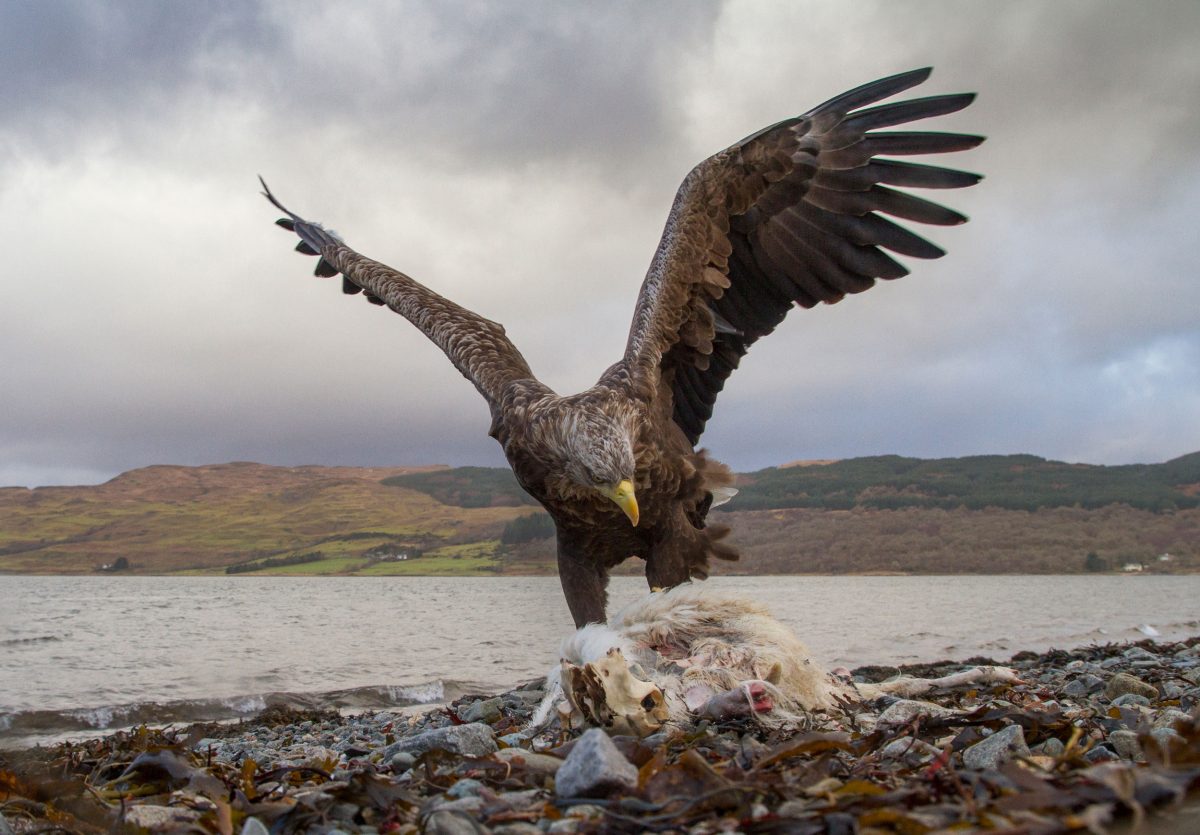
White-tailed eagles are predators, but they’re also opportunistic feeders and will scavenge livestock carcasses. Photo by Scotland: The Big Picture/Minden Pictures
Farmers are particularly annoyed that conservationists long denied that eagles ever preyed on live lambs. Sexton and other bird experts acknowledge that this may occasionally happen, but they still maintain that the eagles are much more likely to scavenge a lamb that has died of something else or steal a lamb from another predator than to attack a perfectly healthy lamb. Sexton’s line is that they are seldom the ultimate cause of death. “Whilst they might have been seen carrying the lamb off, or indeed feeding on it, and it might even still be warm, they didn’t start the process, right? They are taking advantage of something that other predators have started,” Sexton says, pointing out that gulls, ravens, and crows are well-known lamb killers. Farmers tend to disagree. Many of my interviews quickly devolve into discussions of exactly how many lambs eagles kill, and I can hear people—farmers and eagle advocates alike—slip into bitter grooves, reciting arguments to me that they have made many, many times before. The eagles, it appeared, had not become an unremarkable part of the flora and fauna over time. They are still making everyone mad.
I sit on a bench overlooking the harbor in the almost comically picturesque town of Tobermory and watch Italians and Londoners with binoculars slung around their necks eat fish and chips and snap selfies. As an environmental journalist who has written frequently about wolf reintroduction in North America, I am a bit depressed. I had been so hopeful that after all these years the eagle would have been thoroughly reintegrated into both the ecosystem and the human-nonhuman community of Mull. In my naive optimism, I assumed that as soon as a generation of farmers grew up in a world with eagles, they would take them for granted as a rightful part of the island’s life. But instead, they nurse a grudge, against the birds and the birds’ advocates. Because every time a glimpse of a magnificently soaring eagle makes them decide that maybe the birds aren’t so bad, they come around a corner on their quad bikes and find a pile of guts and wool and wonder if an eagle has just blithely killed yet another of their lambs.

The white-tailed eagle is a close relative of North America’s bald eagle, also a sea eagle. Photo by Angus Child/Alamy Stock Photo
I think back to a conversation I had had on the train toward Mull. A young woman told me that the first time she had taken the journey through the Highlands, she had become overcome by the beauty of the landscape and had felt an almost out-of-body sensation, as if she were “flying alongside the train.” I was happy for her, but when I looked out of the window, I saw a landscape that looked a lot like my home in Oregon—except denuded. The basics looked right: the steep mountains, the little rocky coastal islands, the moist air. But instead of being clothed up to their summits by a tangle of temperate rainforest, the mountains were covered with sheep lawn. There are extensive timber plantations in the Highlands and on the Hebrides as well, including on Mull, but the endless rows of same-aged Sitka spruce don’t host much biodiversity and don’t look quite right to my eye either.
On my journey to Mull, I picked up a copy of The Lost Rainforests of Britain by Guy Shrubsole. He argues that some 20 percent of Britain—much of the western coast, including especially the Scottish Highlands and Hebrides—was once temperate rainforest, similar to the old-growth forests in Washington and British Columbia. According to the map in the book, thousands of years ago, Mull could have been nearly all forest, a woodland of pine, oak, hazel, and elm. And presumably any white-tailed eagles living there at that time would have lived a life similar to forest-dwelling bald eagles in the Pacific Northwest: nesting on tall snags above the canopy, working the forest–beach edge, fishing for salmon and mackerel, hunting ducks and seabirds, stealing prey from other predatory species, maybe nabbing the odd otter pup. Today, while fish and birds are available to white-tailed eagles, they are also confronted with a vast swath of open land, populated, each spring, with newborn lambs taking their first wobbly steps, exposed and knock-kneed, weighing just 2.5 kilograms. It would be kind of bizarre if they didn’t eat some lambs.
Around 3,000 people live on Mull and neighboring islands. The economy relies on farming, fishing, fish farming, forestry, and tourism. Video by Scott MacDonald
Returning to a world before sheep is not the goal of most British conservationists—nor should it be. Nature is dynamic, not static, and it is neither possible nor desirable to simply roll back all human changes on the land. But taking a deeper time perspective helps me see that there have been many Mulls over the millennia, and it enlarges my sense of what might be possible in the future. I realize I had been expecting some kind of frictionless coexistence to develop on Mull purely based on goodwill. Maybe hill farming was simply not fully compatible with dense eagle populations. But then which use of the land should have priority? Sheep or eagles? White-tailed eagles are not globally endangered. They are so common in Russia, Norway, and China that the species is ranked as least concern by the International Union for Conservation of Nature. So the argument for their presence isn’t that the white-tailed eagle needs to be saved. The argument is these sea eagles belong on Mull. But many would also say that sheep belong on Mull.
Like many countries, Scotland subsidizes its farming industry to ensure some level of domestic food security, to prop up rural economies, and to protect cultural landscapes. The Scottish government heavily subsidizes hill farming, paying farmers £61.25 ($77.06) a head for ewes. Although there are policies in place to avoid extreme overcrowding, the per-head payments encourage farmers to run many animals, creating intense levels of grazing. Where grazing is heavy, soil can be eroded and compacted, plants struggle to flower and set seed, birds who feed on insects have nothing to eat. And yet lamb prices are so low that without subsidies, the whole enterprise would be unprofitable. The wool is worth so little it is often simply thrown away or burnt. Hill farming is even less profitable than lowland sheep farming. One of the routes by which the Scottish government subsidizes hill farming is literally called the Less Favoured Area Support Scheme, an admission that these areas are simply less suited for producing lamb.
Some Scottish farmers are also enrolled in agri-environment schemes, which pay them to manage their land for biodiversity. Maintaining traditional diverse hedgerows, delaying grazing fields until ground-nesting birds like corncrakes have fledged, building bridges for livestock so they won’t trample stream banks—all these and many more actions can earn money for farmers. But with the per-head ewe payment calling, the end result is that taxpayers fund opposing government actions: a largely unprofitable agricultural industry that tends to destroy biodiversity and relatively small-scale efforts to mitigate that destruction.
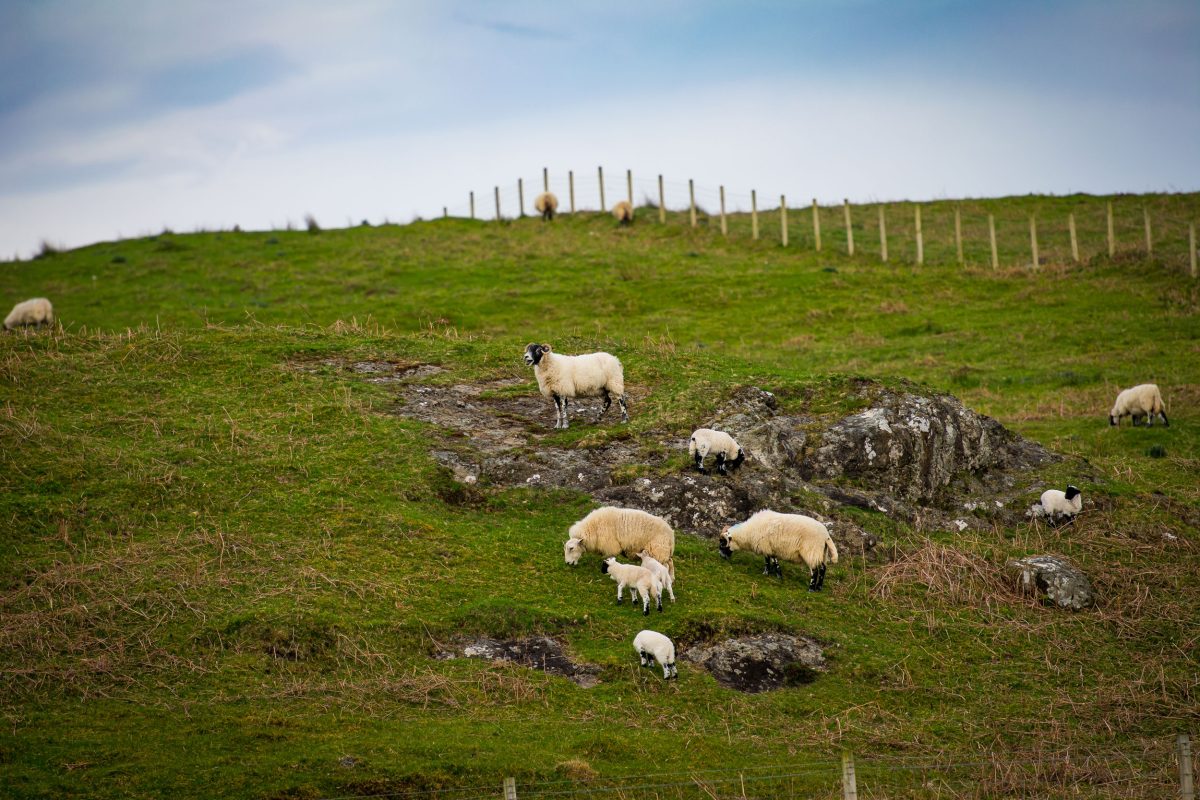
Hill farming—raising animals and sometimes crops on hard-to-cultivate slopes—is common in Scotland, Wales, and northern England. Photo by Scott MacDonald
In large part, the continued support for hill farming is cultural. People expect the Scottish countryside to be close shorn and sheep dotted. In 2009, a representative of the National Farmers Union warned of the consequences if sheep farming were to continue to decline on Mull, telling a government minister, “As an island, we are also very reliant on our tourist trade but our beautiful scenery is also at risk if abandoned land is allowed to run to scrub and bracken rather than being grazed and managed.”
Some tourists might actually appreciate the scrub, especially those being guided by Ewan Miles. Miles has spent 13 years on Mull, working in nature tourism. He began working on a tourist boat, then opened his own land-based wildlife watching business in 2015, beginning with a single seven-seater vehicle. Today, he has two nine-seater vehicles and two seasonal naturalists running tours. Miles has thought a lot about the dominance of hill farming. And he imagines a different way. What if instead of sheep, farmers raised pigs and cattle in densities that would echo the way the wild boar and the extinct cattle ancestor known as the auroch may have once acted on the landscape? And what if revenue from these animals was just part of a property’s income, along with payments for carbon sequestration and biodiversity? Baby Highland calves and piglets would be less vulnerable to eagles, and with less grazing there would be more habitat for hares and grouse, which could be alternative prey for eagles.
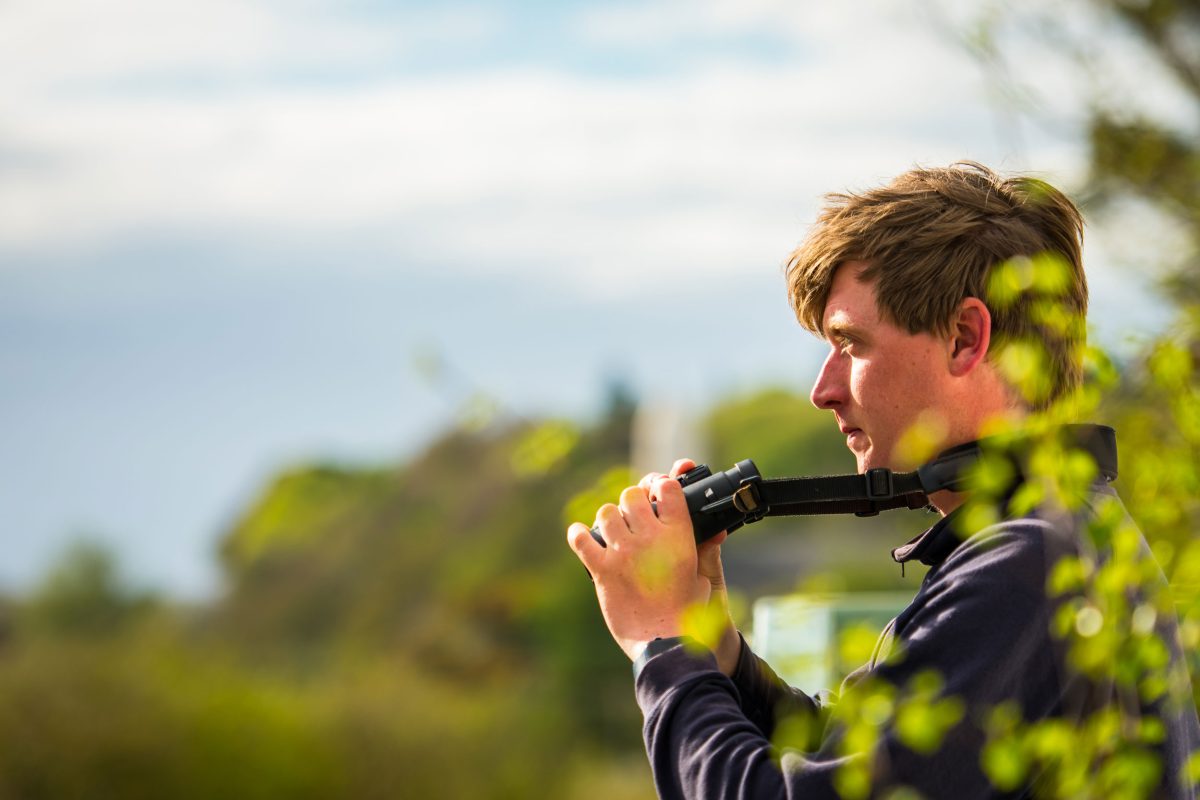
Ewan Miles opened his own land-based wildlife watching business on Mull in 2015. Photo by Scott MacDonald
I am thrilled by his vision. A solution! A way forward. Maybe sheep are, after all, not the future of Mull—although I can well imagine this idea would not be enthusiastically welcomed by sheep farmers themselves. I ask Miles who are the most open-minded and biodiversity-oriented sheep farmers he knows. I want to speak to someone who might represent the future instead of the present, which seems to be dominated by an endless loop of arguments about eagles and lambs. He suggests a couple, Carolyne and Somerset Charrington at Treshnish Farm. They raise lambs but also host guests in beautiful rental cottages—guests who are often traveling to Mull in part to see eagles.
On the road to Treshnish, I drive past a well-known eagle watching hotspot called Loch Na Keal. All along the shore of the lake, people with scopes and binoculars sit and wait, scanning the skies for those big, rectangular outspread wings, dark and squared-off, like a flat-screen TV. Some are in lawn chairs outside their camper vans; others are perched on rocks like big birds themselves. There is something reverent about them, as if they are pilgrims awaiting a visitation.
I am expecting the Charringtons to be eagle fans, given the way Miles described their commitment to caring for nature, but I am immediately disabused of this expectation. Even before our cups of tea are ready, they have begun explaining how eagles are a much worse menace than the conservationists make out. Somerset explains that when lambs simply vanish, eagles are the most obvious explanation. After all, he says, “the only way out of the field is up.” The couple are also a bit skeptical of my wild-eyed ideas about reforesting Mull, creating wet and mossy rainforests where eagles could thrive. Stop grazing and all you would reap would be an endless monoculture of bracken fern, they say. Getting an entire diverse forest back would take forever.
Frustrated, I push the Charringtons, demanding some kind of solution to the conflict. “There is no solution,” Somerset says. “The eagles are here, and they’re here to stay. Full stop. And we have to farm within that.”
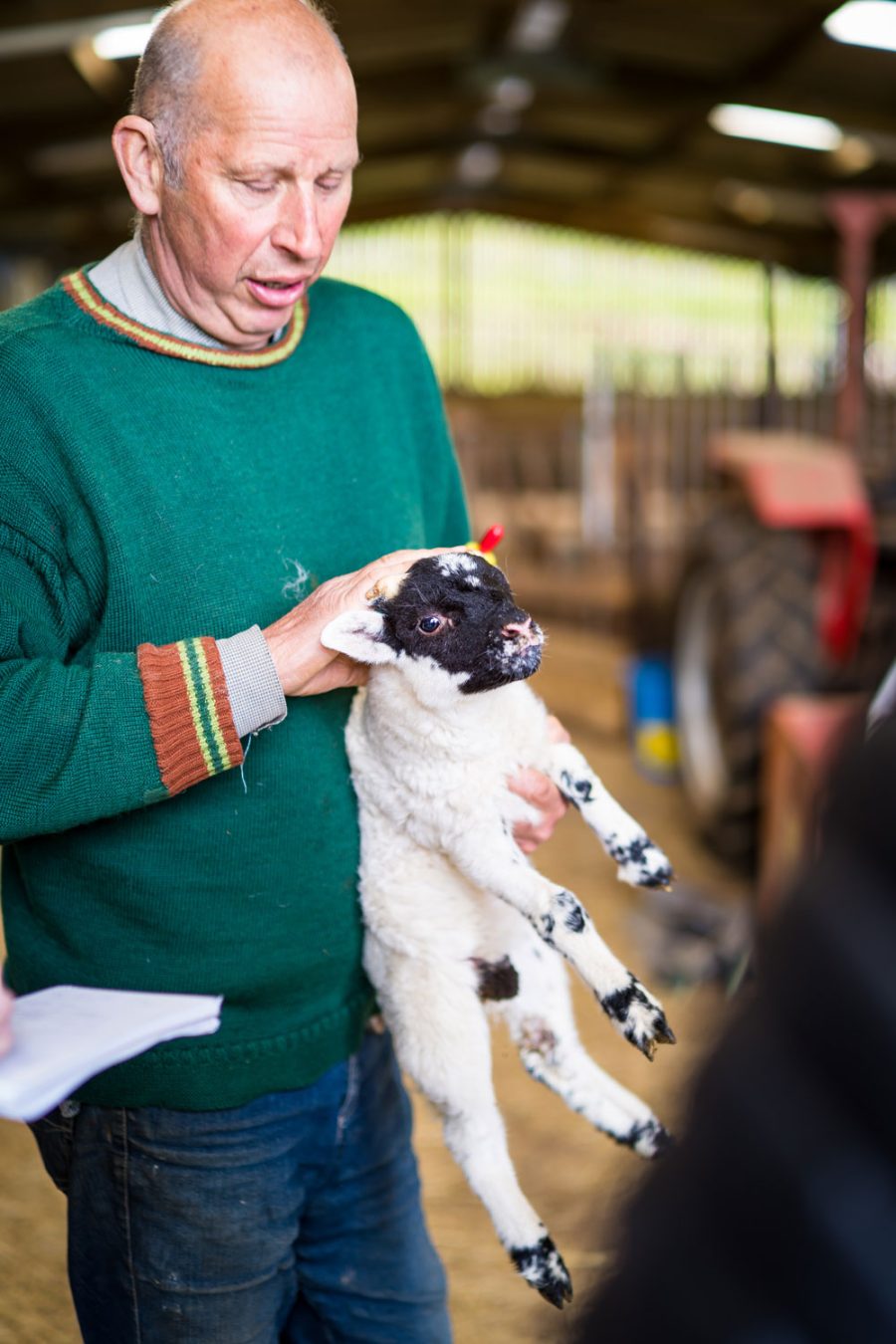
Somerset Charrington, co-owner of Treshnish Farm on Mull, with one of his many lambs. Photo by Scott MacDonald
I find this response hard to process. No solution? Farmers will just continue to raise sheep, eagles will continue to eat them, farmers will remain furious and angry, and it will just go on like that forever?
As we walk out of the house and toward the lambing barn, where ewes giving birth for the first time are housed so they can be helped, Carolyne says that each lamb lost to an eagle hurts her deeply. And yet, like so many other farmers, she can also see their charm. “I hate what they do, but they are still jaw dropping when you see them flying,” she says. Then she tells me that the way she and Somerset farm is heavily shaped by government farm policy. If government farming policy shifted to favor cattle over sheep, or to put more money in biodiversity than in ewes, they’d shift along with it.
The Scottish government is in fact in the midst of a process to revise its agricultural policy now that the United Kingdom is no longer part of the European Union. Mairi Gougeon, cabinet secretary for rural affairs, has promised a “robust and coherent framework to underpin Scotland’s future agriculture support regime from 2025 onwards, that delivers high quality food production, climate mitigation and adaptation, and nature restoration.”
The next day, I follow a woodland trail from Tobermory to a lighthouse on a point. Clambering around on a rocky beach, I find a dead gull, its bloody head popped off its shoulders but still attached by a snaky length of exposed vertebrae. I smell the sweet smell of death. Was it a sea eagle at work?
With the stench still in my nose, I consider that many countries have recently decided to reintroduce predators, inviting them back to lived-in landscapes despite knowing full well how they make their living. Is this a mark of ecological maturity? Or is it perhaps also a bit of showing off—a bit of “conspicuous conservation” by which we show off the affluence of our societies. “See?” we say. “We are so well off that we can let these wild animals feast on our livestock and absorb the loss.”
There is an inherent violence in biodiversity. Behind that dry-sounding term are complex food webs: plants eating sunlight, herbivores eating plants, predators eating herbivores, scavengers and detritivores eating the leftovers. Death—often violent death—is the mechanism by which energy flows from individual to individual, from species to species. Death is also the chisel that carves out new biodiversity, the mechanism by which natural selection slices away “unfit” variants to reveal new genetic combinations: new species.
Somerset Charrington was correct in a very deep sense when he said there was “no solution” to the conflict between eagles and lambs. The Scottish government could retool its agricultural and environmental policies to reduce the dominance of sheep farming in many areas. It could spend more to pay farmers to produce and maintain biodiversity and sequester carbon. The Mull of the far future might have significantly fewer sheep, perhaps more cattle or pigs, more rainforest. But if eagles are to stay, it will not have less death. Whether it be a lamb, a hare, a grouse, or a mackerel, the eagles must eat.

